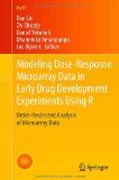
Modeling dose-response microarray data in early drug development experiments using R: order restricted analysis of microarray data
Lin, Dan
Shkedy, Ziv
Yekutieli, Daniel
Amaratunga, Dhammika
This book focuses on the analysis of microarray data in the dose-response setting in early drug development experiments in the pharmaceutical industry, thegoal being to cover this important topic in early drug development and to provide user-friendly software – R library IsoGene – and a GUI package that can be used to analyze dose-response microarray data. It is intended for biostatisticians in the pharmaceutical industry, biologists who conduct dose-response microarray experiments, and biostatistics/bioinformatics graduate students. All methodological issues in the book are illustrated using four “real-world” examples of early drug development dose-response microarray experiments. In Part Iwe discuss the dose-response setting and the problem of estimation of normal means under order restrictions. In particular we discuss the pooled-adjacent-violator (PAV) algorithm, isotonic regression, as well as the likelihood ratio test, which will be used in the second part of the book. The core part of the book is Part II. We start with a brief overview of the specific setting of dose-response microarray experiments together with a discussion about the setting, data structure, and the case studies that will be analyzed in later chapters. We demonstrate the use of the IsoGene R library and in particular its graphical capacity. We then focus on the multiplicity problem, which arises when thousands of genes are tested simultaneously. Although multiple testing is discussed in many books and publications related to microarray data analysis, our goal here is to discuss the main concepts and to illustrate how each method can be implemented in practice. In the next step we shift gears and discuss four test statistics that can be used to test for gene significance. We discuss the issue of resampling-based inference and the use of the SAM technique when small-variance genes are present in the data. All the methods discussed in this chapter are implemented in the IsoGene library and the discussion of any methodological issues will be backed up with an illustration of implementation using the IsoGene library. In the following chapters we discuss the issue of identification of the dose-response curve shape, first providing an exploratory tool,an order-restricted bi-clustering technique, which can be used to identify genes with similar dose-response curve shapes before discussing a more formal method to classify the dose-response curves using information criteria. Bayesianmodels for dose-response microarray data are then discussed, as are model-based approaches, before turning to the concept of multiple contrast tests in theclosing chapters. This book focuses on the analysis of microarray data in the dose-response setting in early drug development experiments in the pharmaceutical industry. Part I discusses the dose-response setting and the problem of estimation of normal means under order restrictions. Part II demonstrates the use of the IsoGene R library and in particular its graphical capacity. INDICE: Introduction. Part I: Dose-response Modeling: An Introduction. Estimation Under Order Restrictions. The Likelihood Ratio Test. Part II: Dose-response Microarray Experiments. Functional Genomic Dose-response Experiments. Adjustment for Multiplicity. Test for Trend. Order Restricted Bisclusters. Classification of Trends in Dose-response Microarray Experiments Using Information Theory Selection Methods. Multiple Contrast Test. Confidence Intervals for theSelected Parameters. Case Study Using GUI in R: Gene Expression Analysis After Acute Treatment With Antipsychotics.
- ISBN: 978-3-642-24006-5
- Editorial: Springer Berlin Heidelberg
- Encuadernacion: Rústica
- Páginas: 285
- Fecha Publicación: 04/01/2012
- Nº Volúmenes: 1
- Idioma: Inglés
